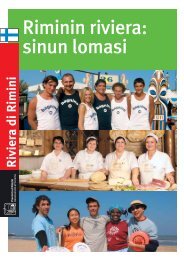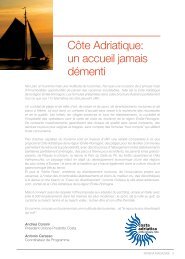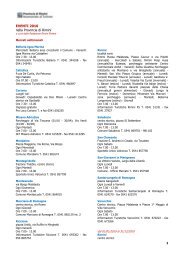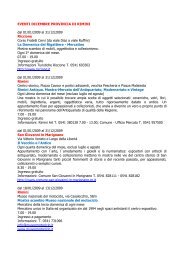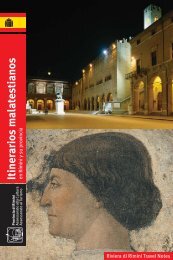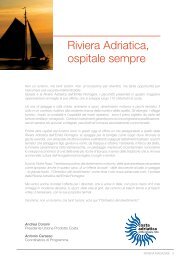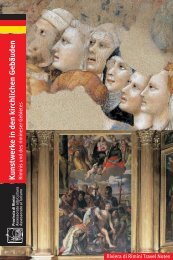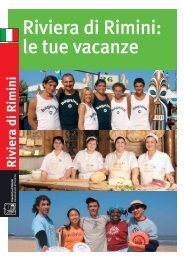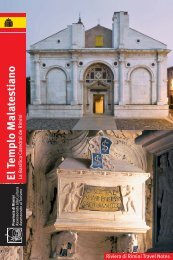Malatesta fortresses and castles
Malatesta fortresses and castles
Malatesta fortresses and castles
- No tags were found...
Create successful ePaper yourself
Turn your PDF publications into a flip-book with our unique Google optimized e-Paper software.
Itinerary 1 > Rimini CastleRiminiCastel Sismondopiazza <strong>Malatesta</strong>tel. 0541 351611 (FondazioneCassa di Risparmio)fax 0541 28660www.fondcarim.itsegreteria@fondcarim.itAbove: Castel Sismondo,Rimini (1437-1446).Below: <strong>Malatesta</strong> medalshowing a view of CastelSismondo (c. 1450).12Rimini Castle is the undisputed masterpiece of <strong>Malatesta</strong>military architecture. Commissioned by Sigismondo in 1437, it wasfinished in 1446, according to the epigraphs with which it is adorned.Their solemn dictation <strong>and</strong> ancient epigraphic style inform the visitorthat the Ruler of Rimini wished to name his castle, which he as usualclaimed to have built a fundamentis, after himself: Castel Sismondo.The construction made use of considerable parts of pre-existingthirteenth-century <strong>Malatesta</strong> dwellings <strong>and</strong> also of the fortificationswhich Sigismondo’s predecessor (his brother Galeotto Roberto,known as The Blessed) had built. To Sigismondo, this castle wasmuch more than just his palace: it was intended to be the visualsymbol of his power, in keeping with a wholly traditional concept,<strong>and</strong> he had it built in the traditional style, more expressivelypicturesque than rationally harmonious, as can be seen from thevariable perspective of the towers, the solidity of the curtain wallssurmounted with merlons, the frequent use of pointed arches <strong>and</strong>stone or ceramic inserts, <strong>and</strong> the splendour of the gilding <strong>and</strong> of thepargetry coloured in red <strong>and</strong> green, the heraldic colours of the<strong>Malatesta</strong>s, all of which were described by contemporary writers. Thetraditional picturesque style continued in the interior, in the tortuouspassageways, the irrational layout of certain rooms, <strong>and</strong> perhaps tooin the scarcity of large reception rooms.To get an idea of the castle’s original appearance today, one hasto refer to the medals cast by Matteo de’ Pasti to celebrate itsconstruction, <strong>and</strong> to a detail of the fresco by Piero della Francesca inthe <strong>Malatesta</strong> Temple (the Cathedral of Rimini), which shows thedesign exactly; or to a page of De Re Militari by Roberto Valturiodedicated to the description <strong>and</strong> praise of this construction <strong>and</strong> ofSigismondo. The inner nucleus of the castle was distinguished by fivetowers which surrounded a tall keep (the palatium);the broad moatwhich marked the outer circuit of the walls extended into the presentPiazza <strong>Malatesta</strong> as far as the rear of the nineteenth-century theatre.The castle’s immense size, mighty appearance <strong>and</strong> irregularshape, designed as a series of fortified enclosures surroundingcentral living quarters, make it striking even today. Someirregularities of design can be explained by the exploitation,necessary or convenient, of pre-existing structures: some, but notall. For example, the positioning of the towers may be attributed inpart to this rationale, but can be also partly seen as an attempt -early <strong>and</strong> so rather uncertain - to create a system of defences withshooting <strong>and</strong> observation points which were to st<strong>and</strong> side by side<strong>and</strong> support one another; a necessity much felt since the




